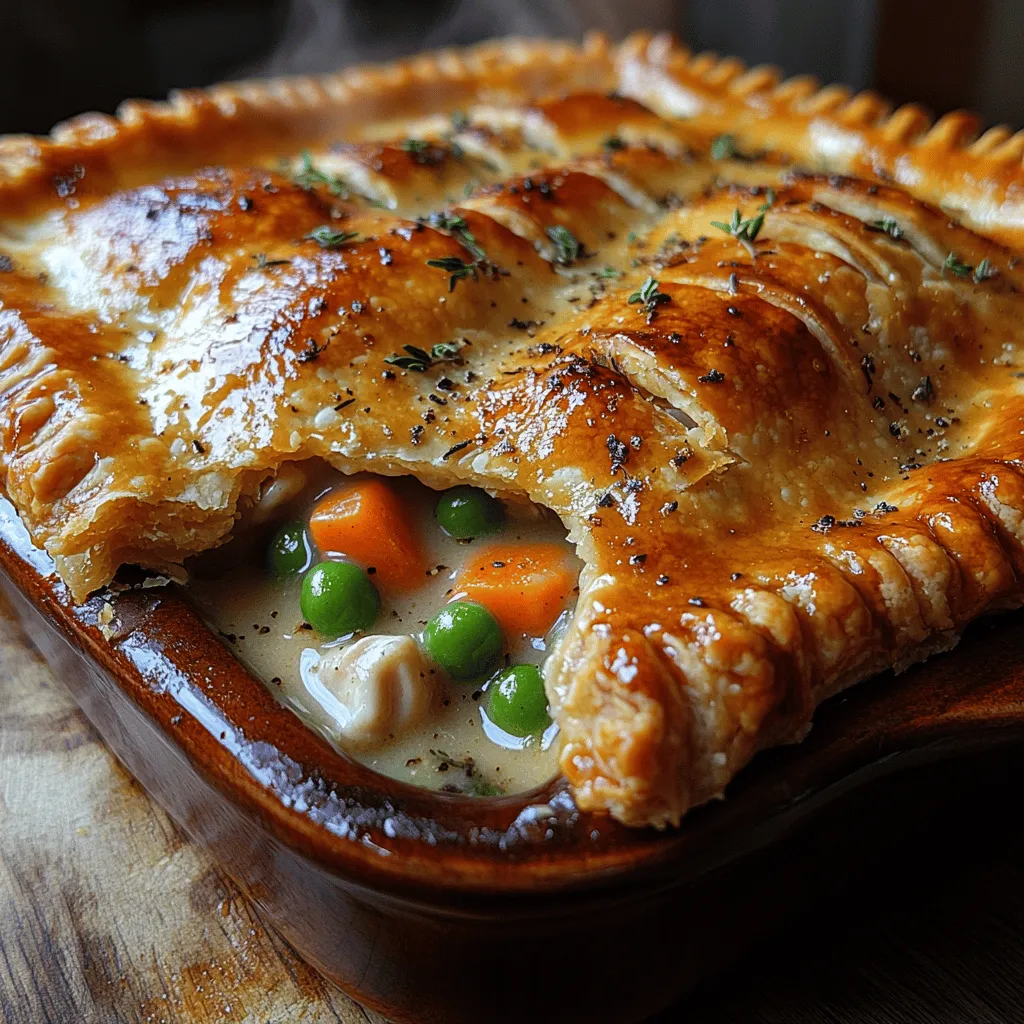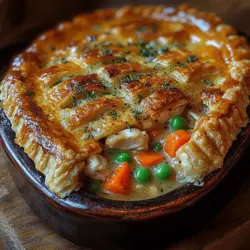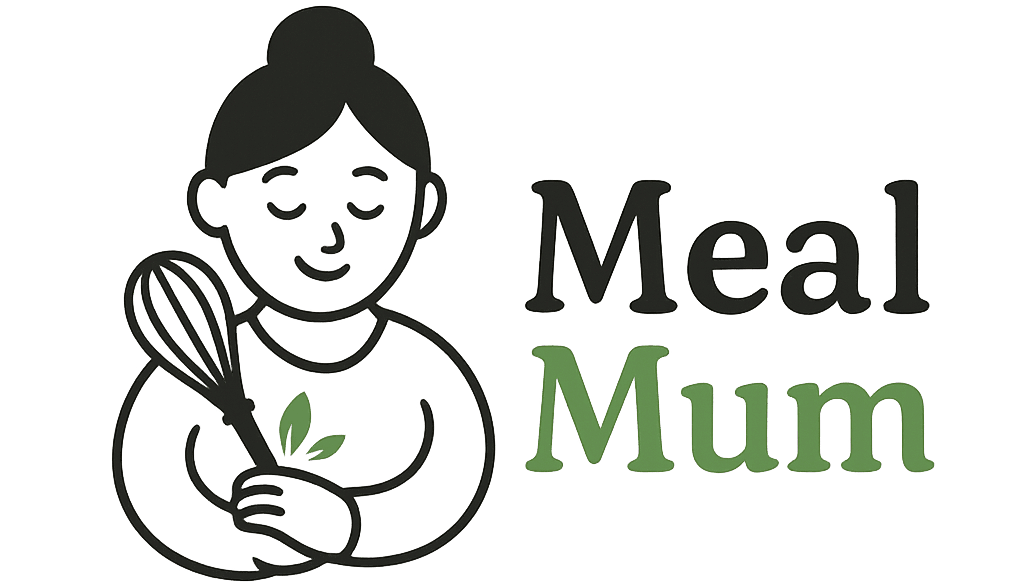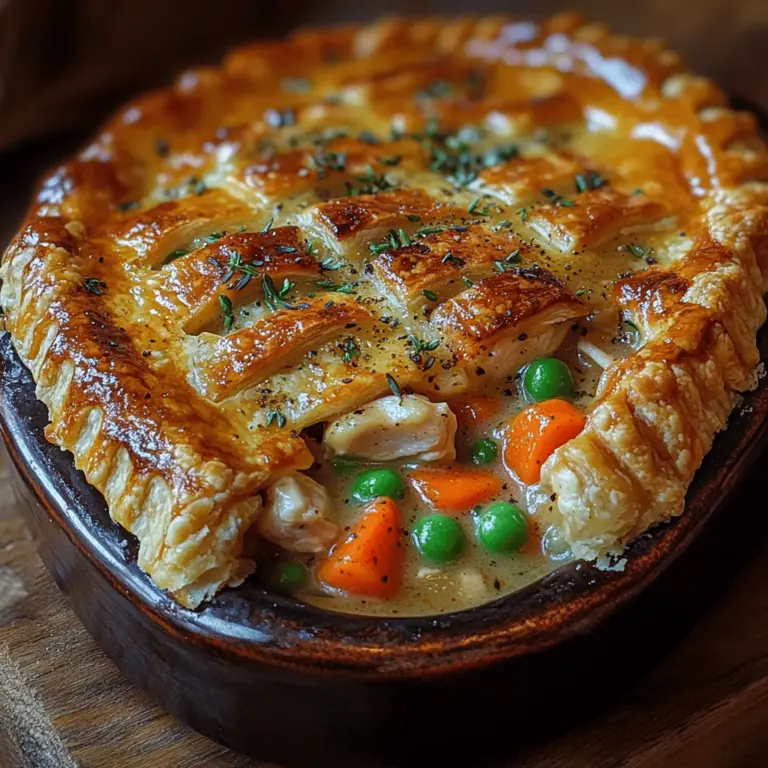Homey Comfort Chicken Pot Pie: A Hearty Embrace of Flavor and Tradition
Chicken pot pie is much more than just a dish; it is a warm embrace of nostalgia, a reminder of cherished family gatherings, and a staple of comfort food that transcends generations. This classic recipe, with its flaky crust encasing a savory filling of tender chicken, vibrant vegetables, and a creamy sauce, transports us back to simpler times. Whether enjoyed on a chilly evening or as a centerpiece for a family dinner, chicken pot pie has an innate ability to evoke feelings of home.
In an era where fast food and convenience meals often dominate our dining tables, the importance of homemade meals cannot be overstated. Preparing a meal from scratch offers not only the satisfaction of creating something delicious but also the chance to infuse it with love and care. The aroma of a freshly baked chicken pot pie wafting through the kitchen is enough to stir memories and create new ones, making it a dish worth mastering.
The Homey Comfort Chicken Pot Pie recipe stands out for its simplicity and heartwarming flavors. With easily accessible ingredients and straightforward preparation steps, this recipe invites cooks of all skill levels to indulge in the joy of homemade cooking. It promises a delightful balance of rich flavors and comforting textures, ensuring that each bite is as fulfilling as the last.
Understanding the Ingredients
To create the perfect chicken pot pie, it is essential to understand the role of each ingredient in the recipe. The key components form the foundation of this beloved dish, each contributing to the overall flavor and texture.
1. Chicken: As the star of the dish, chicken provides a rich source of protein and contributes to the pot pie’s hearty essence. Whether you opt for rotisserie chicken for convenience or choose to poach or roast chicken breasts yourself, the key is to ensure the meat is tender and flavorful.
2. Vegetables: A medley of vegetables typically populates a chicken pot pie, with carrots, peas, and celery being the most common choices. These ingredients not only add vibrant color but also infuse the filling with essential vitamins and minerals. The natural sweetness of the carrots and the freshness of peas create a delightful contrast to the savory chicken.
3. Herbs and Seasoning: Fresh herbs such as thyme and parsley enhance the dish’s flavor profile, while salt and pepper elevate the taste of the filling. Seasoning is critical; it can transform a good dish into a great one. A careful balance of herbs can evoke the essence of home-cooked meals, making every bite memorable.
4. Pie Crust: The choice between a pre-made or homemade pie crust can significantly impact the final result. A homemade crust, while requiring a bit more time and effort, tends to yield a flakier and more flavorful base. On the other hand, a high-quality store-bought crust offers convenience without sacrificing too much on taste. Whichever option you choose, the crust serves as the perfect vessel that holds all the delicious filling.
5. Creamy Sauce: A rich, creamy sauce binds the chicken and vegetables together, ensuring that every forkful is packed with flavor. Typically made with a combination of butter, flour, chicken broth, and heavy cream, the sauce adds a luscious texture that envelops the other ingredients.
Preparation Steps for the Perfect Chicken Pot Pie
Creating the Homey Comfort Chicken Pot Pie begins with careful preparation. Follow these steps to ensure that your pot pie turns out delicious every time.
Preheating the Oven
Before diving into the cooking process, it’s essential to preheat your oven to 425°F (220°C). This step ensures that the pie cooks evenly and that the crust achieves the desired golden-brown color. A hot oven is crucial for creating that flaky texture that makes chicken pot pie so irresistible.
Cooking the Chicken
If you’re using raw chicken, start by seasoning it with salt and pepper and cooking it until it’s no longer pink in the center. This can be achieved by poaching, roasting, or sautéing. For poaching, simmer the chicken in seasoned water or broth until fully cooked, then shred it into bite-sized pieces. If you prefer roasting, place the seasoned chicken breasts on a baking sheet and roast until fully cooked, allowing it to develop a deeper flavor. The key is to ensure the chicken remains moist and tender, providing the perfect base for your filling.
Sautéing the Vegetables
Next, it’s time to sauté the vegetables. In a large skillet, melt some butter over medium heat and add diced onions, carrots, and celery. Sauté these for about 5-7 minutes until they soften and become fragrant. Adding frozen peas towards the end of cooking will help maintain their bright color and crisp texture. This step not only brings out the natural sweetness of the vegetables but also enhances their nutritional value by ensuring they retain their vibrant colors and flavors.
Making the Sauce
The creamy sauce is what truly binds the chicken and vegetables together. In the same skillet, create a roux by adding a bit more butter and flour to the sautéed vegetables. Cook for a couple of minutes to eliminate the raw flour taste, then gradually whisk in chicken broth and heavy cream. Stir continuously until the sauce thickens to a velvety consistency. This creamy mixture will coat the chicken and vegetables, ensuring every bite is rich and satisfying.
Combining Ingredients
Once the sauce has reached the desired thickness, it’s time to combine the cooked chicken and sautéed vegetables. Pour the chicken and vegetable mixture into a large mixing bowl and fold in the creamy sauce until everything is evenly coated. This is the moment where all the flavors come together, creating a harmonious filling that will be the heart of your pot pie.
With these initial steps completed, you are well on your way to preparing a comforting chicken pot pie that is sure to warm your heart and satisfy your taste buds. The next stage involves assembling the pie and preparing it for baking—stay tuned for the complete guide to creating your perfect Homey Comfort Chicken Pot Pie.

Rolling Out the Crust: Techniques for Ease and Uniformity
Creating the perfect crust for your chicken pot pie is essential for achieving that delicious, flaky texture we all crave. Start by chilling your dough in the refrigerator for at least 30 minutes before rolling it out. This step firms up the fat, making it easier to handle and ensuring a tender crust.
When you’re ready to roll out the dough, lightly flour your work surface and rolling pin to prevent sticking. Begin rolling from the center outwards, applying even pressure to create a uniform thickness. Aim for about 1/8 inch thick, which is ideal for a sturdy yet tender pie crust. If your dough cracks at the edges, simply press it back together; don’t worry about perfection, as this is a homey dish meant to be enjoyed rather than judged on presentation.
If you’re making a double crust, roll out the second dough disk while the first is resting in the pie dish. This way, you can keep the dough cold, which will result in a flakier crust when baked. Once rolled out, transfer the crust to your pie dish by gently rolling it onto the rolling pin and then unrolling it into place. Trim any excess dough hanging over the edges, leaving about an inch to allow for crimping.
Filling the Pie: Importance of Layering and Portion Control
When it comes to filling your chicken pot pie, layering and portion control are key to achieving a balanced flavor in every bite. Start by preparing your filling: sauté onions, carrots, and celery until tender, then add cooked, shredded chicken and a rich, creamy sauce made from chicken broth, cream, and seasonings.
To layer the filling, begin by placing a generous amount at the bottom of the pie crust. Don’t overfill; you want to leave some space for the top crust to fit comfortably. A well-balanced filling ensures that each slice maintains the right ratio of crust to filling, leading to a delightful eating experience. Aim for about 2 to 3 cups of filling depending on the size of your pie dish.
Once the filling is in place, sprinkle some fresh herbs like thyme or parsley for an extra burst of flavor. This not only enhances the taste but also adds a pop of color to the pie, making it visually appealing.
Sealing and Decorating the Pie: Creative Ideas for Aesthetic Appeal
Now that your filling is in place, it’s time to seal and decorate your pie. Lay the second rolled-out crust over the filled pie, making sure to align it with the edges of the bottom crust. To seal the pie, crimp the edges together using your fingers or a fork, pressing down firmly to ensure a good seal. This prevents any filling from bubbling over during baking.
For added flair, consider creating decorative cutouts in the top crust. Use cookie cutters to make shapes like leaves or stars and place them on top of the pie. Not only does this enhance the aesthetic appeal, but it also allows steam to escape during baking, preventing the crust from becoming soggy.
The Significance of the Egg Wash for a Golden Finish
To achieve that beautiful golden-brown crust, an egg wash is essential. Whisk together one egg with a tablespoon of milk or water and brush it generously over the top crust before baking. This not only gives the pie a lovely sheen but also helps to create a crispy texture that contrasts wonderfully with the creamy filling beneath.
For an added touch, sprinkle some coarse salt or dried herbs over the egg wash for extra flavor and visual appeal.
Baking and Serving
Recommended Baking Time and Temperature for Optimal Results
Preheat your oven to 425°F (220°C) before placing your pie inside. The high temperature is crucial for achieving that flaky crust and ensuring the filling is heated through. Bake the chicken pot pie for 30-35 minutes, or until the crust is golden brown and the filling is bubbling.
Signs That the Pie Is Fully Baked
You’ll know your chicken pot pie is fully baked when the crust reaches a rich golden color and you can see the filling bubbling through the vents or cutouts in the top crust. If you notice the crust browning too quickly, cover the edges with aluminum foil to prevent burning while allowing the center to finish cooking.
Cooling Time: Why It’s Essential for the Best Serving Experience
Once out of the oven, let the pie cool for at least 15-20 minutes before serving. This cooling period allows the filling to set, making it easier to slice and serve without the ingredients spilling out. While the anticipation might be tempting, patience is key for the best texture and presentation.
Pairing Suggestions
Ideal Side Dishes to Serve with Chicken Pot Pie
Chicken pot pie is a hearty dish that stands well on its own, but you can enhance your meal with a few complementary side dishes. Consider a simple green salad with a light vinaigrette to balance the richness of the pie. Steamed vegetables like broccoli or green beans can also add a fresh element to your meal.
For a heartier accompaniment, garlic mashed potatoes or buttery corn on the cob can elevate the comfort food experience.
Beverage Pairings That Complement the Flavors
When it comes to beverage pairings, a crisp white wine like Sauvignon Blanc or Chardonnay can cut through the richness of the pot pie beautifully. If you prefer non-alcoholic options, a sparkling apple cider or even a refreshing iced tea can provide a delightful contrast to the savory flavors of the dish.
Ideas for Garnishing to Enhance Presentation
Garnishing your chicken pot pie can take it from homemade to gourmet. Consider sprinkling fresh chopped parsley or thyme over the top just before serving for a pop of color. You could also place a small sprig of rosemary or thyme on each individual slice for an elegant touch.
Storage Tips for Leftovers
Best Practices for Storing Leftover Chicken Pot Pie
If you find yourself with leftover chicken pot pie, store it in an airtight container in the refrigerator. It’s best to consume leftovers within 3-4 days for optimal flavor and texture. If you anticipate having leftovers, consider baking the pie in a disposable aluminum pan for easy storage and reheating.
Recommendations for Reheating While Maintaining Texture and Flavor
To reheat your chicken pot pie, preheat your oven to 350°F (175°C). Place the slice on a baking sheet and cover it loosely with aluminum foil to prevent the crust from burning. Heat for about 20-25 minutes, or until warmed through. This method helps maintain the crispy texture of the crust while ensuring the filling is heated evenly.
Potential Uses for Leftover Filling in Other Dishes
If you have leftover filling, don’t let it go to waste! It can be repurposed into a comforting chicken and vegetable soup, added to a casserole, or even used as a filling for homemade quesadillas. The possibilities are endless, allowing you to enjoy the flavors of your chicken pot pie in new and exciting ways.
Conclusion
Chicken pot pie is more than just a meal; it represents comfort, warmth, and the joys of home-cooked food. This classic dish has a way of bringing family and friends together, creating lasting memories around the dinner table. By following this detailed recipe, you can create a delicious chicken pot pie that will surely become a family favorite.
We encourage you to try your hand at making this comforting dish, and share the joy of cooking with your loved ones. Whether it’s a chilly evening or a festive gathering, chicken pot pie is sure to provide a fulfilling meal experience that warms the heart. Embrace the process, savor the flavors, and enjoy every moment spent in the kitchen.


